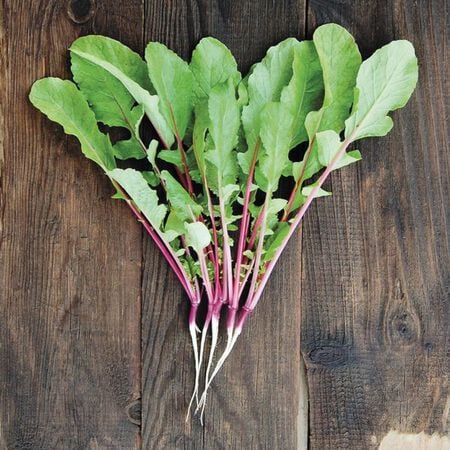Hong Vit, Radish Seeds
Key Attributes
Key Attributes
Product Details
Weight
.008Plant Height
4-14"Botanical Name
Raphanus sativusSeed Type
SeedSeeds Per Gram
93Seeds Per Pound
42,300Row Spacing
12-18"Packet
250 SeedsSow Depth
1/2"Seeds Per Ounce
2,644Fruit Color
RedBreed
Open-pollinatedSun
Full SunTypes
SPECIALTY RADISHESMaturity
Early SeasonGrowing Conditions
Container FriendlyCubic Inches
2.925Life Cycle
AnnualSow Method
Direct SowPlant Spacing
1"Categories
RadishGermination
6,7,8,9,10Days To Maturity (# Days)
20Seeds Per Acre
15 lbsComponents
Growing Instructions
![]() Learning Download: How to Grow Microgreens
Learning Download: How to Grow Microgreens
Microgreens are a quick, delicate and nutrient-rich crop that can be added to salads or eaten fresh. Microgreens are useful as they required little space, time and expertise to grow. Microgreens are similar to sprouts, although only the delicate greens are eaten and not the germinated seed.
Before Planting: Ideal soil temperature is 75°F until germination, then reduced to 60°F for growing. Temperatures above 75° can increase disease pressure and inhibit germination. Grow on potting mix or soilless medium of your choice in shallow trays.
Planting: Broadcast seed thickly on the media surface with seeds 1/8- 1/4″ apart, press seeds firmly into media for maximum soil contact, and cover lightly with sowing mix, vermiculite, or humidity dome. Microgreens can be germinated on heat mats, in germination chambers, or on greenhouse benches or floors.
Watering: Bottom water or mist to prevent sowing mix from splashing on the seedlings. Maintain even moisture and do not allow sowing medium to dry out.
Fertilizer: Most medias will have some form of nutrient which should be enough for growing microgreens to size, such as potting mix, plain water is usually best. Watering with a dilute fertilizer solution from bottom is appropriate for media with no inherent nutrient value.
Days to Maturity: Fast-growing varieties are typically ready for harvest in 10-15 days while slow-growing varieties are ready in 16-25 days.
Harvesting: Once microgreens are desired size, cut with scissors or a sharp knife and minimize handling to reduce damage.
Tips: Consider supplemental lighting in any environment where natural light is insufficient.
Shipping Schedule
Our Seed Promise
 "Agriculture and seeds" provide the basis upon which our lives depend. We must protect this foundation as a safe and genetically stable source for future generations. For the benefit of all farmers, gardeners and consumers who want an alternative, we pledge that we do not knowingly buy or sell genetically engineered seeds or plants.
"Agriculture and seeds" provide the basis upon which our lives depend. We must protect this foundation as a safe and genetically stable source for future generations. For the benefit of all farmers, gardeners and consumers who want an alternative, we pledge that we do not knowingly buy or sell genetically engineered seeds or plants.
The mechanical transfer of genetic material outside of natural reproductive methods and between genera, families or kingdoms, poses great biological risks as well as economic, political, and cultural threats. We feel that genetically engineered varieties have been insufficiently tested prior to public release. More research and testing is necessary to further assess the potential risks of genetically engineered seeds. Further, we wish to support agricultural progress that leads to healthier soils, to genetically diverse agricultural ecosystems, and ultimately to healthy people and communities.
To learn more about the "Safe Seed Pledge" please visit www.councilforresponsiblegenetics.org.

